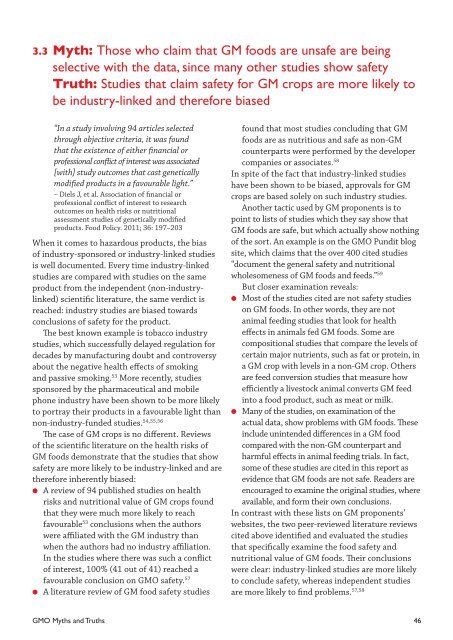GMO Myths and Truths
GMO Myths and Truths
GMO Myths and Truths
You also want an ePaper? Increase the reach of your titles
YUMPU automatically turns print PDFs into web optimized ePapers that Google loves.
3.3 Myth: Those who claim that GM foods are unsafe are being<br />
selective with the data, since many other studies show safety<br />
Truth: Studies that claim safety for GM crops are more likely to<br />
be industry-linked <strong>and</strong> therefore biased<br />
“In a study involving 94 articles selected<br />
through objective criteria, it was found<br />
that the existence of either financial or<br />
professional conflict of interest was associated<br />
[with] study outcomes that cast genetically<br />
modified products in a favourable light.”<br />
– Diels J, et al. Association of financial or<br />
professional conflict of interest to research<br />
outcomes on health risks or nutritional<br />
assessment studies of genetically modified<br />
products. Food Policy. 2011; 36: 197–203<br />
When it comes to hazardous products, the bias<br />
of industry-sponsored or industry-linked studies<br />
is well documented. Every time industry-linked<br />
studies are compared with studies on the same<br />
product from the independent (non-industrylinked)<br />
scientific literature, the same verdict is<br />
reached: industry studies are biased towards<br />
conclusions of safety for the product.<br />
The best known example is tobacco industry<br />
studies, which successfully delayed regulation for<br />
decades by manufacturing doubt <strong>and</strong> controversy<br />
about the negative health effects of smoking<br />
<strong>and</strong> passive smoking. 53 More recently, studies<br />
sponsored by the pharmaceutical <strong>and</strong> mobile<br />
phone industry have been shown to be more likely<br />
to portray their products in a favourable light than<br />
non-industry-funded studies. 54,55,56<br />
The case of GM crops is no different. Reviews<br />
of the scientific literature on the health risks of<br />
GM foods demonstrate that the studies that show<br />
safety are more likely to be industry-linked <strong>and</strong> are<br />
therefore inherently biased:<br />
● A review of 94 published studies on health<br />
risks <strong>and</strong> nutritional value of GM crops found<br />
that they were much more likely to reach<br />
favourable 53 conclusions when the authors<br />
were affiliated with the GM industry than<br />
when the authors had no industry affiliation.<br />
In the studies where there was such a conflict<br />
of interest, 100% (41 out of 41) reached a<br />
favourable conclusion on <strong>GMO</strong> safety. 57<br />
● A literature review of GM food safety studies<br />
found that most studies concluding that GM<br />
foods are as nutritious <strong>and</strong> safe as non-GM<br />
counterparts were performed by the developer<br />
companies or associates. 58<br />
In spite of the fact that industry-linked studies<br />
have been shown to be biased, approvals for GM<br />
crops are based solely on such industry studies.<br />
Another tactic used by GM proponents is to<br />
point to lists of studies which they say show that<br />
GM foods are safe, but which actually show nothing<br />
of the sort. An example is on the <strong>GMO</strong> Pundit blog<br />
site, which claims that the over 400 cited studies<br />
“document the general safety <strong>and</strong> nutritional<br />
wholesomeness of GM foods <strong>and</strong> feeds.” 59<br />
But closer examination reveals:<br />
● Most of the studies cited are not safety studies<br />
on GM foods. In other words, they are not<br />
animal feeding studies that look for health<br />
effects in animals fed GM foods. Some are<br />
compositional studies that compare the levels of<br />
certain major nutrients, such as fat or protein, in<br />
a GM crop with levels in a non-GM crop. Others<br />
are feed conversion studies that measure how<br />
efficiently a livestock animal converts GM feed<br />
into a food product, such as meat or milk.<br />
● Many of the studies, on examination of the<br />
actual data, show problems with GM foods. These<br />
include unintended differences in a GM food<br />
compared with the non-GM counterpart <strong>and</strong><br />
harmful effects in animal feeding trials. In fact,<br />
some of these studies are cited in this report as<br />
evidence that GM foods are not safe. Readers are<br />
encouraged to examine the original studies, where<br />
available, <strong>and</strong> form their own conclusions.<br />
In contrast with these lists on GM proponents’<br />
websites, the two peer-reviewed literature reviews<br />
cited above identified <strong>and</strong> evaluated the studies<br />
that specifically examine the food safety <strong>and</strong><br />
nutritional value of GM foods. Their conclusions<br />
were clear: industry-linked studies are more likely<br />
to conclude safety, whereas independent studies<br />
are more likely to find problems. 57,58<br />
<strong>GMO</strong> <strong>Myths</strong> <strong>and</strong> <strong>Truths</strong> 46


